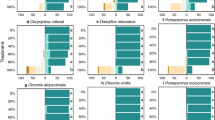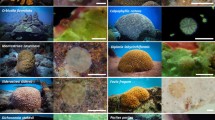Abstract
Planktivorous fishes are known to consume coral larvae due to their high nutritional value that can benefit both the individual and their progeny. However, how the consumption of coral larvae varies among coral and fish taxa, between day and night and with the density of coral larvae is not well understood. Here, we used a series of laboratory feeding assays to determine how the consumption of coral larvae by five planktivorous damselfish species (Abudefduf sexfasciatus, Amblyglyphidodon curacao, Dascyllus trimaculatus, D. reticulatus, and Chromis viridis) differed (1) between larvae of the broadcast-spawning scleractinian coral Acropora tenuis and the brooding non-scleractinian coral Heliopora coerulea when offered at a constant density (100 larvae/50 L), (2) between day and night (A. tenuis only), and (3) among larval densities (A. tenuis: 5–500 larvae/50 L; H. coerulea: 5–250 larvae/50 L). When coral larvae were offered at 100 larvae/50 L, all five fish species examined consumed A. tenuis (78–97 larvae h−1) at a greater rate than H. coerulea (23–57 larvae h−1), with these differences likely related to the behavior and/or pigmentation of the larvae. Consumption also varied among the fishes examined, though the differences were small when compared to differences between coral species. Consumption of A. tenuis was twofold higher at day than night likely reflecting the diurnally active feeding behavior of the fishes examined. When the density of coral larvae offered to the fishes was varied, three of five species exhibited a type II functional response (decelerating intake rate) for A. tenuis, while four out of five damselfish species exhibited a type III (sigmoidal intake rate) or type I (linear intake rate) for H. coerulea. This study demonstrates that predation by fishes contributes significantly to coral larvae mortality and that differences in consumption rates among coral species may affect the composition of coral recruits and ultimately coral assemblages.



Similar content being viewed by others
References
Abecia JE, Guest JR, Villanueva RD (2016) Geographical variation in reproductive biology is obscured by the species problem: a new record of brooding Porites cylindrica, or misidentification? Invertebr Biol 135:58–67
Arai T, Kato M, Heyward A, Ikeda Y, Iizuka T, Maruyama T (1993) Lipid composition of positively buoyant eggs of reef building corals. Coral Reefs 12:71–75
Atrigenio M, Aliño P, Conaco C (2017) Influence of the blue coral Heliopora coerulea on scleractinian coral larval recruitment. J Mar Biol. https://doi.org/10.1155/2017/6015143
Babcock RC, Bull GD, Harrison PL, Heyward AJ, Oliver JK, Wallace CC, Willis BL (1986) Synchronous spawning of 105 scleractinian coral species on the Great Barrier Reef. Mar Biol 90:379–394
Burnam KP, Anderson DR (2002) Multimodel inference: understanding AIC and BIC in model selection. Sociol Methods Res 33:261–304
Bates D, Machler M, Bolker B, Walker S (2015) Fitting linear mixed-effects models using lme4. Journal of Statistical Software 67:1–48
Cowan ZL, Dworjanyn SA, Caballes CF, Pratchett MS (2016) Predation in crown-of-thorns starfish larvae by damselfishes. Coral Reefs 35:1253–1262
Frederich B, Oliver D, Gajdzik Parmentier E (2018) Trophic ecology of damselfishes. In: Parmentier E, Frederich B (eds) Biology of Damselfishes. CRC Press Taylor & Francis, Boca Raton, FL
Frederich B, Fabri G, Lepoint G, Vandewalle P, Parmentier E (2009) Trophic niches of thirteen damselfishes (Pomacentridae) at the Grand Recif of Toliara, Madagascar. Ichthyol Res 56:10–17
Graham EM, Baird AH, Conolly SR (2008) Survival dynamics of scleractinian coral larvae and implications for dispersal. Coral Reefs 27:529–539
Graham NAJ, Evans RD, Russ GR (2003) The effects of marine reserve protection on the trophic relationships of reef fishes on the Great Barrier Reef. Environmental Conservation 30(2):200–208
Guest J, Heyward A, Omori M, Iwao K, Morse A, Boch C (2010) In Edwards A (eds.): Reef Rehabilitation Manual. Coral Reef Targeted Research and Capacity Building for Management Program: St Lucia, Australia. Ii + 166 pp
Hall VR, Hughes TP (1996) Reproductive strategies of modular organisms: comparative studies of reef building corals. Ecology 77:950–963
Hamner WM, Jones MS, Carleton JH, Hauri IR, McB Williams (1988) Zooplankton, planktivorous fishes, and water currents on a windward reef face: Great Barrier Reef. Australia. Bulletin of Marine Science 42(3):459–479
Harii S, Nadaoka K, Yamamoto M, Iwao K (2007) Temporal changes in settlement, lipid content and lipid composition of larvae of the spawning hermatypic coral Acropora tenuis. Mar Ecol Prog Ser 346:89–96
Harii S, Kayane H, Takigawa H, Hayashibara T, Yamamoto M (2002) Larval survivorship, competency periods and settlement of two brooding corals, Heliopora coerulea and Pocillopora damicornis. Mar Biol 141:39–46
Harrison PL (2010) Sexual reproduction of scleractinian corals. In: Dubinsky Z, Stambler N (eds) Coral Reefs: An Ecosystem in Transition. Springer, New York, p 562
Harrison PL, Wallace CC (1990) Reproduction, dispersal and recruitment of scleractinian corals. In: Dubinsky Z (ed) Ecosystems of the World: Coral Reefs. Elsevier, New York, pp 133–202
Harrison PL, Babcock RC, Bull GD, Oliver JK, Wallace CC, Willis BL (1984) Mass spawning in tropical reef corals. Science 223:1186–1189
Hassel MP (1978) The dynamics of arthropod predator-prey systems. Princeton University Press, Princeton, NJ, p 237
Heyward AJ, Babcock RC (1986) Self- and cross-fertilization in scleractinian corals. Marine Biology 90:191–195
Hobson ES (1991) Trophic relationships of fishes specialized to feed on zooplankters above coral reefs. In Sale P (eds.) The Ecology of Fishes on Coral Reefs. Academic Press. 754 pp
Holling CS (1959a) The components of predation as revealed by a study of small mammal predation of the European pine sawfly. Can Entomol 91:293–320
Holling CS (1959b) Some characteristics of simply types of predation and parasitism. Can Entomol 91:385–398
Hughes TP, Baird AH, Dinsale EA, Molstchaniwskyj NA, Pratchett MS, Tanner JE, Willis BL (2000) Supply-side ecology works both ways: the link between benthic adults, fecundity, and larval recruits. Ecology 81:2241–2249
Hughes TP, Kerry JT, Álvarez-Noriega M, Álvarez-Romero JG, Anderson KD, Baird AH, Babcock RC, Beger M, Bellwood DR, Berkelmans R, Bridge TC (2017) Global warming and recurrent mass bleaching of corals. Nature 543:373–377
Hughes TP, Kerry JT, Baird AH, Connolly SR, Dietzel A, Eakin CM, Heron SF, Hoey AS, Hoogenboom MO, Liu G, McWilliam MJ (2018) Global warming transforms coral reef assemblages. Nature 556:492–496
Hughes TP, Kerry JT, Baird AH, Connolly SR, Chase TJ, Dietzel A, Hill T, Hoey AS, Hoogenboom MO, Jacobson M, Kerswell A, Madin JS, Mieog A, Paley AS, Pratchett MS, Torda G, Woods RM (2019) Global warning impairs stock-recruitment dynamics of corals. Nature 568:387–391
Jamodiong EA, Maboloc EA, Leriorato JC, Tañedo MCS, Diaz LA, Tabalanza TD, Cabaitan PC, Villanueva RD (2017) Coral spawning and spawn-slick observation in the Philippines. Mar Biodiv. https://doi.org/10.1007/s12526-017-0680-9
Jeschke JM, Kopp M, Tollrian R (2004) Consumer-food systems: why type I functional responses are exclusive to filter feeders. Biol Rev 79:337–349
Leray M, Alldredge AL, Yang JY, Meyer CP, Holbrook SJ, Schmitt RJ, Knowlton N, Brooks AJ (2019) Dietary partitioning promotes the coexistence of planktivores species of corals. Mol Ecol 28:2694–2710
Linquist N, Hay ME (1996) Palatability and chemical defense of marine invertebrate larvae. Ecol Monogr 66(4):431–450
Marshall PA, Baird AH (2000) Bleaching of corals on the Great Barrier Reef: differential susceptibilities among taxa. Coral Reefs 19:155–163
Murdoch WW (1973) Functional response of predators. J Appl Ecol 10:335–342
Murdoch WW, Oaten A (1975) Predation and population stability. Adv Ecol Res 9:1–131
Nilson PA, Ruxton GD (2004) Temporarily fluctuating prey and interfering predators: a positive feedback. Anim Behav 68:159–165
Nozawa Y, Okubu N (2011) Survival dynamics of reef coral larvae with special consideration of larvae size and the genus Acropora. Biol Bull 220:15–22
Oliver JK, Willis BL (1987) Coral-spawn slicks in the Great Barrie Reef: preliminary observations. Mar Biol 94:521–529
Paterson RA, Dick JTA, Pritchard DW, Ennis M, Hatcher MJ, Dunn AM (2014) Predicting invasive species impacts: a community module functional response approach reveals context dependencies. J Anim Ecol. https://doi.org/10.1111/1365-2656.12292
Pratchett MS, Gust N, Goby G, Klanten SO (2001) Consumption of coral propagules represents a significant trophic link between corals and fish. Coral Reefs 20:13–17
Pritchard DW, Paterson RA, Bovy HC, Barrios-O’Neil D (2017) FRAIR: an R package for fitting and comparing functional responses. Meth Ecol Evol. https://doi.org/10.1111/2041-210X.12784
R Core Team (2018) R: A Language and Environment for Statistical Computing. R Foundation for Statistical Computing, Vienna, Austria. https://www.R-project.org/
Real LA (1977) The kinetics of functional response. Am Nat 111:289–300
Vicentuan KC, Guest JR, Baria MV, Cabaitan PC, Dizon RM, Villanueva RD, Aliño PM, Edwards AJ, Gomez ED, Heyward AJ (2008) Multi-specific spawning of corals in north-western Philippines. Coral Reefs 27:83
Villanueva RD (2016) Cryptic speciation in the stony coral Heliopora coerulea: temporal reproductive isolation between two growth forms. Mar Biodiv 46:503–507
Villanueva RD, Edwards AJ (2010) Butterflyfishes feed on externally brooded larvae of the blue coral, Heliopora coerulea. Coral Reefs 29:105
Villanueva RD, Yap HT, Montano MNE (2008) Timing of planulation by pocilloporid corals in the northwestern Philippines. Mar Ecol Prog Ser 370:111–119
Westneat MW, Resing JAM (1988) Predation on coral spawn by planktivorous fishes. Coral Reefs 7:89–92
Wyatt ASJ, Waite AM, Humphries S (2012) Stable isotope analysis reveals community-level variation in fish trophodynamics across fringing coral reef. Coral Reefs 31:1029–1044
Zaret TM (1972) Predators, invisible prey, and the nature of polymorphism in the Cladocera (Class Crustacea). Limnol Oceanogr 17:171–184
Zaret TM, Kerfoot WC (1975) Fish predation on Bosmina longirostris: body-size selection versus visibility selection. Ecology 56:232–237
Acknowledgements
We are grateful to F. Castrence, N. Adolfo, N. Uriarte, R. de Guzman, E. Gomez, C. Ligson, D. dela Cruz, J.N. Requilme, B. Padayhag, S. Sayco and I de Guzman for their invaluable aid in preparing and conducting the experiments. This study was predominantly funded by the MSc thesis grant of the Bolinao Marine Laboratory, University of the Philippines (BML-MSC-18-01), awarded to T.J. Quimpo, with subsequent assistance from the OVPAA Balik-PhD program (OVPAA-BPhD-2017-01) awarded to P.C. Cabaitan. Logistical support was provided by the Australian Center for International Agricultural Research (ACIAR)-funded research of P. Harrison on restoring damaged coral reefs using mass coral larval reseeding. We thank the two anonymous reviewers for their constructive comments. This is MSI contribution no. 467.
Author information
Authors and Affiliations
Corresponding author
Ethics declarations
Conflict of interest
On behalf of all authors, the corresponding author states that there is no conflict of interest.
Additional information
Topic Editor Michael Lee Berumen
Publisher's Note
Springer Nature remains neutral with regard to jurisdictional claims in published maps and institutional affiliations.
Electronic supplementary material
Below is the link to the electronic supplementary material.
Rights and permissions
About this article
Cite this article
Quimpo, T.J.R., Cabaitan, P.C. & Hoey, A.S. Differential consumption of scleractinian and non-scleractinian coral larvae by planktivorous damselfishes. Coral Reefs 38, 1293–1301 (2019). https://doi.org/10.1007/s00338-019-01859-9
Received:
Accepted:
Published:
Issue Date:
DOI: https://doi.org/10.1007/s00338-019-01859-9




